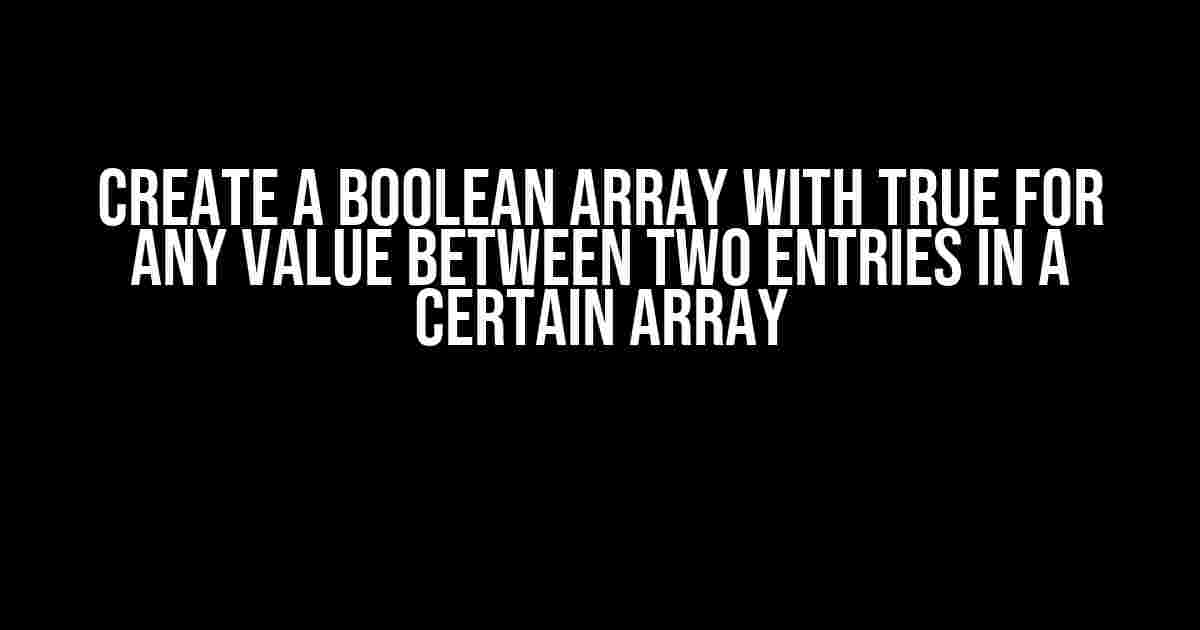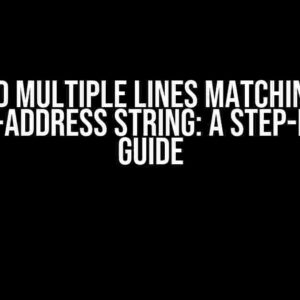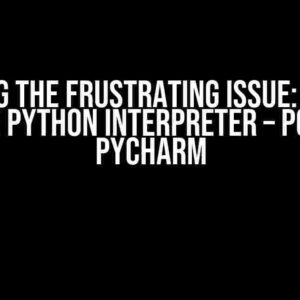Are you tired of sifting through arrays, trying to identify specific values and create boolean arrays based on those values? Well, worry no more! In this article, we’ll show you how to create a boolean array with True for any value between two entries in a certain array. Yes, you read that right – we’re going to make your life easier with this simple yet powerful technique.
But First, Let’s Set the Stage
Before we dive into the solution, let’s establish a scenario that requires this approach. Imagine you’re working on a project that involves analyzing a large dataset, and you need to identify specific ranges within that dataset. For instance, let’s say you’re working with a list of exam scores, and you want to create a boolean array that indicates which scores fall between 70 and 90. Sounds familiar?
The Problem Statement
Given an array of values, create a boolean array where True represents any value between two specified entries in the original array. In our example, we want to create a boolean array that’s True for scores between 70 and 90.
original_array = [50, 60, 70, 75, 80, 85, 90, 95, 100]
lower_bound = 70
upper_bound = 90
The Solution
Now that we’ve set the stage, let’s get to the solution. We’ll use Python as our programming language of choice, but the concept applies to any language. We’ll create a boolean array using a simple, yet elegant approach.
boolean_array = (original_array >= lower_bound) & (original_array <= upper_bound)
What’s happening here? We’re using two conditional statements to create our boolean array. The first part, `(original_array >= lower_bound)`, checks if each value in the original array is greater than or equal to the lower bound (70). The second part, `(original_array <= upper_bound)`, checks if each value is less than or equal to the upper bound (90). The `&` operator is used to combine these two conditions, ensuring that both must be True for the corresponding value in the boolean array to be True.
Breaking it Down
Let’s break down the solution step by step:
(original_array >= lower_bound): This creates a boolean array where True represents values greater than or equal to the lower bound (70).(original_array <= upper_bound): This creates a boolean array where True represents values less than or equal to the upper bound (90).&operator: This combines the two boolean arrays, ensuring that both conditions must be True for the corresponding value in the resulting boolean array to be True.
The Result
Now that we've created our boolean array, let's take a look at the result:
boolean_array = [False, False, True, True, True, True, True, False, False]
Voilà! Our boolean array indicates which values in the original array fall between 70 and 90. The True values correspond to scores 70, 75, 80, 85, and 90, while the False values represent scores outside this range.
Real-World Applications
This technique has numerous real-world applications in various fields, including:
- Data analysis: Identify specific ranges within large datasets.
- Machine learning: Create boolean arrays for feature engineering or data preprocessing.
- Scientific computing: Filter data based on specific criteria, such as temperature ranges or pressure levels.
Conclusion
In this article, we've demonstrated how to create a boolean array with True for any value between two entries in a certain array. By using conditional statements and the `&` operator, we can efficiently identify specific ranges within datasets. This technique is a powerful tool in your programming arsenal, and we're confident you'll find it useful in your future projects.
Bonus: Extending the Solution
What if you want to create a boolean array for multiple ranges within the same array? Easy! Simply modify the solution to accommodate multiple conditions:
lower_bound_1 = 70
upper_bound_1 = 90
lower_bound_2 = 40
upper_bound_2 = 60
boolean_array = ((original_array >= lower_bound_1) & (original_array <= upper_bound_1)) | ((original_array >= lower_bound_2) & (original_array <= upper_bound_2))
In this example, we're creating a boolean array that's True for values between 70 and 90 or between 40 and 60. The `|` operator is used to combine the two conditions, ensuring that either range can result in a True value in the boolean array.
| Range | Lower Bound | Upper Bound |
|---|---|---|
| Range 1 | 70 | 90 |
| Range 2 | 40 | 60 |
With this technique, you can create boolean arrays for any number of ranges, making it a versatile tool for your data analysis and processing tasks.
Final Thoughts
We hope this article has provided you with a valuable solution for creating boolean arrays with True for any value between two entries in a certain array. Remember, the power of programming lies in its ability to simplify complex tasks, and with this technique, you'll be able to tackle a wide range of problems with ease.
Happy coding, and don't forget to share your thoughts and questions in the comments below!
Frequently Asked Question
Are you struggling to create a boolean array with True for any value between two entries in a certain array? Worry no more! We've got the answers to your burning questions.
How do I create a boolean array in Python?
You can create a boolean array in Python using the NumPy library. Simply import NumPy and use the `numpy.array()` function to create an array with the desired values. For example: `import numpy as np; bool_array = np.array([True, False, True, False])`.
What is the syntax to create a boolean array with True for any value between two entries in a certain array?
The syntax is as follows: `bool_array = (array >= min_value) & (array <= max_value)`, where `array` is the input array, `min_value` is the minimum value, and `max_value` is the maximum value.
How do I execute the above syntax in a Python script?
First, import the NumPy library. Then, define the input array and the minimum and maximum values. Finally, execute the syntax and print the resulting boolean array. Here's an example: `import numpy as np; array = np.array([1, 2, 3, 4, 5, 6]); min_value = 2; max_value = 5; bool_array = (array >= min_value) & (array <= max_value); print(bool_array)`.
What is the output of the above Python script?
The output will be a boolean array with True for values between 2 and 5 (inclusive) and False otherwise. In this case, the output will be: `[False, True, True, True, True, False]`.
Can I use this approach for arrays with non-numeric values?
No, this approach is specific to numeric arrays. For non-numeric arrays, you'll need to use a different approach, such as using the `in` operator or list comprehension to create a boolean array.




